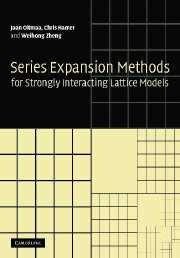Book contents
- Frontmatter
- Contents
- Preface
- 1 Introduction
- 2 High- and low-temperature expansions for the Ising model
- 3 Models with continuous symmetry and the free graph expansion
- 4 Quantum spin models at T = 0
- 5 Quantum antiferromagnets at T = 0
- 6 Correlators, dynamical structure factors and multi-particle excitations
- 7 Quantum spin models at finite temperature
- 8 Electronic models
- 9 Review of lattice gauge theory
- 10 Series expansions for lattice gauge models
- 11 Additional topics
- Appendix 1 Some graph theory ideas
- Appendix 2 The ‘pegs in holes’ algorithm
- Appendix 3 Free graph expansion technicalities
- Appendix 4 Matrix perturbation theory
- Appendix 5 Matrix block diagonalization
- Appendix 6 The moment–cumulant expansion
- Appendix 7 Integral equation approach to the two-particle Schrödinger equation
- Appendix 8 Correspondences between field theory and statistical mechanics
- Appendix 9 Computer programs
- Bibliography
- Index
11 - Additional topics
Published online by Cambridge University Press: 06 January 2010
- Frontmatter
- Contents
- Preface
- 1 Introduction
- 2 High- and low-temperature expansions for the Ising model
- 3 Models with continuous symmetry and the free graph expansion
- 4 Quantum spin models at T = 0
- 5 Quantum antiferromagnets at T = 0
- 6 Correlators, dynamical structure factors and multi-particle excitations
- 7 Quantum spin models at finite temperature
- 8 Electronic models
- 9 Review of lattice gauge theory
- 10 Series expansions for lattice gauge models
- 11 Additional topics
- Appendix 1 Some graph theory ideas
- Appendix 2 The ‘pegs in holes’ algorithm
- Appendix 3 Free graph expansion technicalities
- Appendix 4 Matrix perturbation theory
- Appendix 5 Matrix block diagonalization
- Appendix 6 The moment–cumulant expansion
- Appendix 7 Integral equation approach to the two-particle Schrödinger equation
- Appendix 8 Correspondences between field theory and statistical mechanics
- Appendix 9 Computer programs
- Bibliography
- Index
Summary
Disordered systems
The physics of systems with a large degree of random structural disorder is a large and fascinating field (see e.g. Ziman, 1979).We will describe, in this section, three major areas of work where series expansion methods have been successfully used. The discussion will be quite brief but should suffice to give the reader a flavour of the field and a guide to possible future work. We will restrict the discussion, at the outset, in two important ways. Firstly, we will consider only lattice systems, leaving aside the important areas of amorphous and ‘glassy’ systems. Secondly, we will only consider the case of ‘quenched’ disorder, which is frozen into place when the system is created. Strictly speaking, such systems are not in complete thermodynamic equilibrium. However in a large system with short range interactions, all configurations are effectively sampled: the system is said to be ‘self averaging’. In model calculations, such as those discussed here, an average over different disordered configurations has to be taken.
Percolation
Let us consider a square lattice containing two kinds of atoms or sites arranged randomly.We will call them ‘white’ and ‘black’. They might, for example, be nonmagnetic and magnetic atoms in an alloy such as CuMn. Let us denote by p the fraction of black sites. As p is increased larger clusters of connected black sites will be expected and, at a critical probability or ‘percolation threshold’ pc, a black cluster of macroscopic (infinite) size will occur for the first time.
- Type
- Chapter
- Information
- Series Expansion Methods for Strongly Interacting Lattice Models , pp. 265 - 282Publisher: Cambridge University PressPrint publication year: 2006

